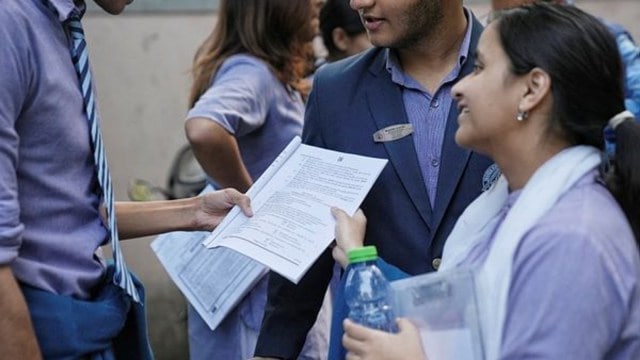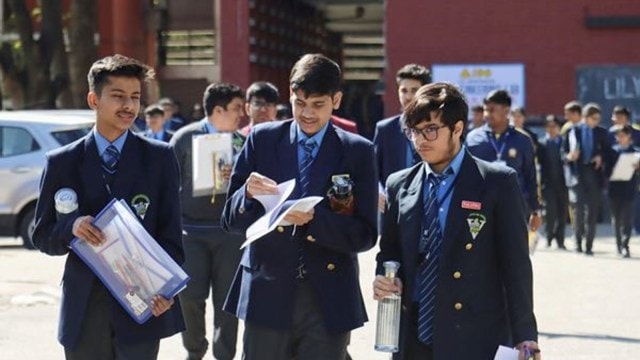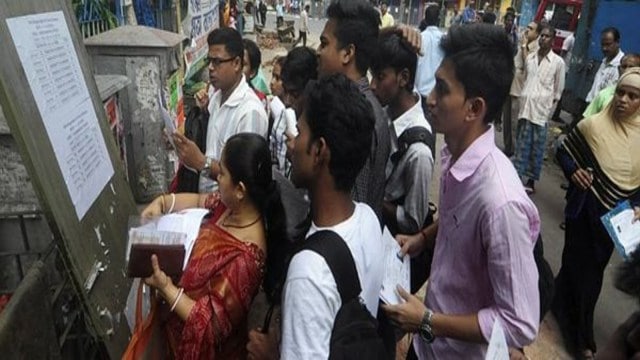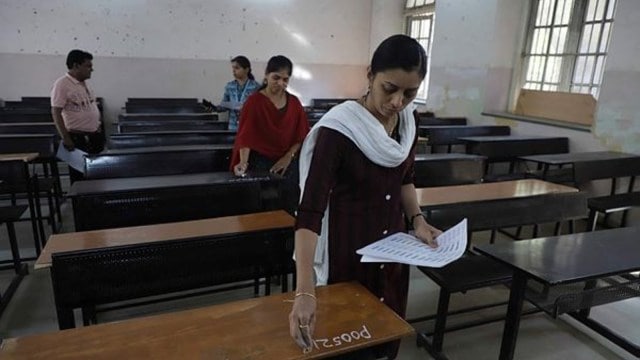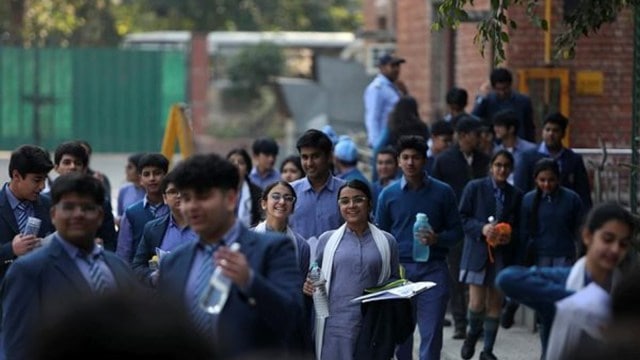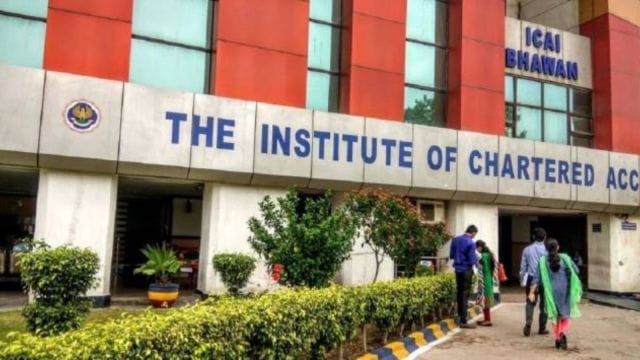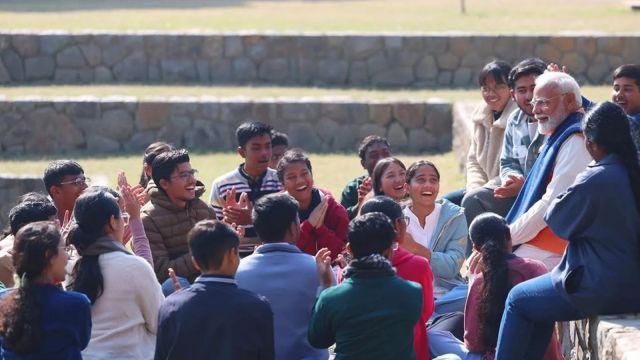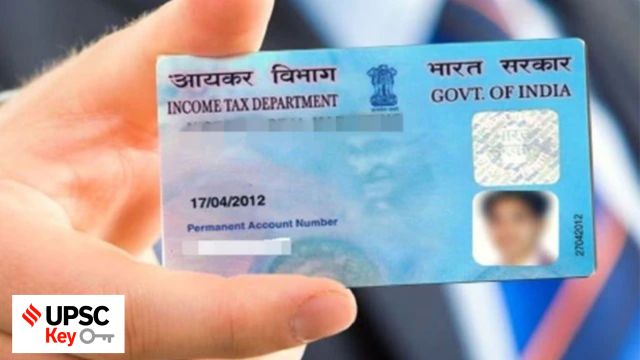
UPSC Key: PAN 2.0, One Nation One Subscription and Preamble of the Indian ConstitutionSubscriber Only
Important topics and their relevance in UPSC CSE exam for November 26, 2024. If you missed the November 25, 2024 UPSC CSE exam key from the Indian Express, read it here
FRONT PAGE
Cabinet clears PAN 2.0, card to feature QR code
Syllabus:
Preliminary Examination: Economic and Social Development-Sustainable Development, Poverty, Inclusion, Demographics, Social Sector Initiatives, etc.
Main Examination: General Studies II: Government policies and interventions for development in various sectors and issues arising out of their design and implementation.
What’s the ongoing story: An upgrade of existing Permanent Account Number (PAN) with an additional feature of QR code on the cards along with a proposal to make PAN “the common identifier for businesses” was approved by the Union Cabinet on Monday.
Key Points to Ponder:
• PAN and PAN 2.0-Compare and Contrast
• Examine the role of PAN in integrating financial systems and promoting digital governance in India.
• Explain the significance of the Permanent Account Number (PAN) in ensuring financial transparency?
• How Permanent Account Number (PAN) helps in curbing tax evasion in India?
• What is the primary purpose of incorporating a QR code into the new PAN 2.0 cards?
• Evaluate the potential challenges that may arise with the implementation of PAN 2.0 featuring QR codes. Suggest measures to address these challenges effectively.
• Analyze the impact of technological advancements, such as the introduction of QR codes in PAN cards, on the transparency and accountability of financial systems in India.
• How does mandatory PAN linkage for high-value transactions help in promoting accountability and reducing unethical practices like money laundering? Discuss with examples.
Key Takeaways:
• The Cabinet approved the PAN 2.0 Project of the Income Tax Department, with a cost of Rs 1,435 crore, under which the existing system will be upgraded completely, the digital backbone will be revamped and PAN will be made as a common business identifier for all digital systems of specified government agencies, Information and Broadcasting Minister Ashwini Vaishnaw said during the Cabinet briefing.
• The upgrade for existing PAN holders will be free of cost.
• The PAN 2.0 project will enable technology-driven transformation of taxpayer registration services with an aim to improve ease of access and service delivery, an official statement said.
• The PAN 2.0 project proposes to make PAN as the “single source of truth and data consistency” and with security and optimisation of infrastructure for greater agility, a statement said.
• The PAN 2.0 is a e-governance project for re-engineering the business processes of taxpayer registration services through transformation of PAN/TAN services, the statement said.
Do You Know:
• The PAN 2.0 Project of the Income Tax Department, with a financial implication of Rs 1,435 crore, was approved by the Union Cabinet on Monday. —Under the project, the existing PAN system will be upgraded completely, the IT backbone will be revamped and PAN will be made as a common business identifier for all digital systems of specified government agencies.
• Apart from the QR-code feature for all new and existing PAN cards, the PAN 2.0 project aims to set up a unified portal along with a “mandatory PAN data vault system” for all entities using PAN data.
• Existing users will have the option to upgrade for the PAN 2.0 card. The details about the application process and the timeline are yet to be released by the Income Tax Department.
• The QR-code feature on new and old PAN cards will mean an enhanced level of integration of financial transactions with the tax department. —The QR code was introduced in PAN in 2017. —The PAN 2.0 project intends to continue with this feature with enhancements, tax officials said.
• A 10-digit alphanumeric number, PAN, enables the Income Tax Department to link all transactions of a person with the department. —These transactions include tax payments, Tax Deducted at Source (TDS) / Tax Collected at Source (TCS) credits, returns of income, specified transactions. —PAN acts as an identifier for the person with the tax department. —Once PAN is allotted, it remains the same forever. It is mandatory to quote PAN on filing of income tax return.
• TAN stands for Tax Deduction and Collection Account Number, which is a 10-digit alphanumeric number issued by the Income Tax Department. —TAN needs to be obtained by all persons responsible for deducting or collecting tax at source. —It is compulsory to quote TAN in TDS/TCS return, any TDS/TCS payment challan, TDS/TCS certificates.
Other Important Articles Covering the same topic:
????PAN 2.0: What is the project, why you need to upgrade your PAN card
Previous year UPSC Prelims Question Covering similar theme: 1. What is the primary purpose of incorporating a QR code into the new PAN 2.0 cards? A) To store additional personal information. B) To link PAN with mobile numbers. C) To facilitate quick verification and reduce fraud. D) To enable online shopping transactions.
IN PARLIAMENT
Kerala wants 8,590 sq km area as eco-sensitive in Western Ghats: Centre
Syllabus:
Preliminary Examination: Current events of national and international importance.
Mains Examination: General Studies III: Conservation, environmental pollution and degradation, environmental impact assessment.
What’s the ongoing story: In a revised proposal sent to the Centre earlier this month, the Kerala government requested the declaration of 8,590.69 sq km across 98 villages and 12 districts as ecologically sensitive areas (ESAs) in the Western Ghats. The area proposed for ESA demarcation is 121 sq km smaller than what was submitted to the Centre in May this year.
Key Points to Ponder:
• What are Eco-sensitive Zone (ESZs)?
• What is the significance of Eco-sensitive Zone (ESZs)?
• Eco-Sensitive Zones are demarcated under the Environment (Protection) Act, 1986-True or false?
• Map Work-Western Ghats
• In the context of Eco-Sensitive Zones in India, the Gadgil and Kasturirangan Committees says what?
• Discuss the significance of the Western Ghats as an ecological hotspot and the challenges faced in balancing conservation and development in the region?
• Critically analyse the implications of designating large areas as Eco-Sensitive Zones in states like Kerala. How does this impact local livelihoods and biodiversity?
• The Western Ghats have been at the centre of debates on sustainable development. Examine the role of policy frameworks like the Gadgil and Kasturirangan reports in shaping conservation strategies.
• “Eco-Sensitive Zones are crucial for the conservation of biodiversity, but they often lead to conflict with local communities.” Elaborate with reference to the recent proposal by Kerala.
Key Takeaways:
• Protection of fragile villages across the state’s Western Ghats area has been under the spotlight following the July 30 landslides and mudslides in Wayanad district’s Chooralmala, Mundakkai and Vellarimala, which killed over 400 people. The state’s draft proposal on ESAs sent in May included 12 villages from Wayanad district, including Vellarimala.
• “The Government of Kerala has submitted revised proposal on 02.11.2024, requesting for declaring 8590.69 sq km area in 98 villages spread across 29 talukas in 12 districts as Ecologically Sensitive Area based on the verification of the suggestions received from the Local Self Government Department,” Union Environment Minister Bhupender Yadav informed Lok Sabha in a written statement
• The Centre issued a sixth iteration of the draft notification on the Western Ghats in July, demarcating 56,825 sq km as ESA across Gujarat, Goa, Maharashtra, Karnataka, Kerala, and Tamil Nadu.
• The villages marked as ESA will see a complete ban on mining, quarrying, highly polluting industries, and new thermal power plants. This draft notification was based on the report of a high-level working group headed by space scientist K Kasturirangan.
• After the sixth iteration of the Western Ghats draft notification was published, the Centre allowed states 60 days to submit objections and suggestions. The expert committee has been taking up the proposals and suggestions of different state governments.
Do You Know:
• In 2013, Kerala proposed demarcating 9,993.7 sq km as ESAs based on the report of a three-member expert panel. Later, in 2019, it submitted to the environment ministry that it should be reduced to 8,656 sq km. However, the latest draft notification continued with the previous iterations and marked the 9.993.7 sq km area as eco-sensitive.
• As per the National Wildlife Action Plan (2002-2016), issued by the Union Ministry of Environment, Forest and Climate Change, land within 10 km of the boundaries of national parks and wildlife sanctuaries is to be notified as eco-fragile zones or Eco-Sensitive Zones (ESZ). —While the 10-km rule is implemented as a general principle, the extent of its application can vary. Areas beyond 10-km can also be notified by the Union government as ESZs, if they hold larger ecologically important “sensitive corridors.”
• According to the guidelines issued by the Environment Ministry on February 9, 2011, ESZs are created as “shock absorbers” for the protected areas, to minimize the negative impact on the “fragile ecosystems” by certain human activities taking place nearby. —These areas are meant to act as a transition zone from areas requiring higher protection to those requiring lesser protection. —The guidelines also state that the ESZs are not meant to hamper the daily activities of people living in the vicinity, but are meant to guard the protected areas and “refine the environment around them”.
Other Important Articles Covering the same topic:
????SC modifies order on eco-sensitive zone around national parks, sanctuaries
Previous year UPSC Prelims Question Covering similar theme: 2. Gadgil Committee Report’ and ‘Kasturirangan Committee Report’, sometimes seen in the news, are related to (UPSC CSE, 2016) a) Constitutional reforms b) Ganga Action Plan c) Linking of rivers d) Protection of Western Ghats
Centre approves new scheme for research journals on one platform
Syllabus:
Preliminary Examination: Economic and Social Development-Sustainable Development, Poverty, Inclusion, Demographics, Social Sector Initiatives, etc.
Main Examination: General Studies II: Issues relating to development and management of Social Sector/Services relating to Health, Education, Human Resources.
What’s the ongoing story: The Union Cabinet on Monday (November 25) approved a budgetary allocation of Rs 6,000 crore for an initiative called ‘One Nation One Subscription’ (ONOS) which the Centre hopes will help India’s higher education institutions (HEIs) access academic resources for the better.
Key Points to Ponder:
• ‘One Nation One Subscription’ (ONOS) scheme-Know in detail
• How ‘One Nation One Subscription’ (ONOS) scheme will enhance skill development?
• “A centralized platform for research journals is essential to enhance India’s position in the global research ecosystem.” Critically analyse this statement in light of the new scheme approved by the Centre.
• Discuss the significance of making research journals accessible to a wider audience. How does this initiative align with India’s goals of achieving self-reliance (Atmanirbhar Bharat) in research and innovation?
• How ‘One Nation One Subscription’ can help in bridging the knowledge divide between rural and urban educational institutions in India.
• What are the challenges that could arise during the implementation of the centralized platform for research journals. Suggest measures to overcome these challenges.
• How does the ONOS scheme reflect the principles of equity and inclusivity in India’s education policy? Suggest ways to maximize its impact.
Key Takeaways:
• The Union Cabinet on Monday approved the ‘One Nation One Subscription’ (ONOS) scheme, which aims to centralise journal subscriptions for nearly 6,300 government-run institutions, ONOS seeks to provide equitable access to 13,000 scholarly journals under a single platform.
• Access will be provided through a national subscription, coordinated by the Information and Library Network (INFLIBNET), an autonomous inter-university center under the University Grants Commission (UGC).
• Currently, there are ten separate library consortia under different ministries that provide access to journals for higher education institutions within their administrative remit. In addition, individual institutions subscribe to journals separately.
• With ONOS, all government higher education institutions, including universities, colleges, and institutions of national importance, will have unified access to national and international journal publications covering all academic disciplines on one platform.
• The scheme involves an outlay of ₹6,000 crore for three years, until 2027, and will provide subscriptions to around 13,000 journals published by 30 international publishers.
• Apart from higher education institutions run by the Centre and states, research and development institutions under the Centre will also be included, covering around 6,300 institutions.
• All 13,000 journals will be accessible to these institutions under the scheme.
• INFLIBNET will make central payments to the 30 publishers, while institutions can continue to use their own budgets to subscribe to publishers not covered under the scheme.
• Among the publishers included in the scheme are Elsevier ScienceDirect, Springer Nature, Wiley Blackwell Publishing, Taylor & Francis, Sage Publishing, Oxford University Press, Cambridge University Press, and BMJ Journals.
• The scheme is expected to provide broader access to research journals for institutions that previously lacked sufficient resources. The platform is set to become operational on January 1, 2025.
Do You Know:
• Currently, higher education institutions (HEIs) can access journals through 10 different library consortia which are under the administrative control of various ministries. —A library consortium is a group of two or more libraries that have agreed to cooperate to fulfil certain similar needs, usually resource sharing. For instance, INFLIBNET Centre (Information and Library Network Centre) in Gandhinagar is an Inter-University Centre of the University Grants Commission under the Ministry of Education (India) which oversees the UGC-Infonet Digital Library Consortium, providing access to selected scholarly electronic journals and databases in different disciplines. —Apart from this, HEIs also subscribe to several journals individually. According to government estimates, roughly 2,500 HEIs can access 8,100 journals through the above networks and individual subscriptions.
• Through the ONOS scheme, the Centre aims to consolidate the disaggregated approach to journal access for all government HEIs. ONOS will enable state and central government HEIs to access thousands of journals on one platform, which will be active from January 1, 2025.
Other Important Articles Covering the same topic:
????First phase of ‘One Nation One Subscription’ approved: How the scheme can improve govt institutions’ access to journals
Previous year UPSC Prelims Question Covering similar theme: 3. Which of the following statements is/are correct regarding National Innovation Foundation-India (NIF)? (2015) 1. NIF is an autonomous body of the Department of Science and Technology under the Central Government. 2. NIF is an initiative to strengthen the highly advanced scientific research in India’s premier scientific institutions in collaboration with highly advanced foreign scientific institutions. Select the correct answer using the code given below: (a) 1 only (b) 2 only (c) Both 1 and 2 (d) Neither 1 nor 2
Flagship Atal Innovation Mission to go on, Cabinet allocates `2,750 crore
Syllabus:
Preliminary Examination: Economic and Social Development-Sustainable Development, Poverty, Inclusion, Demographics, Social Sector Initiatives, etc.
Main Examination: General Studies II: Government policies and interventions for development in various sectors and issues arising out of their design and implementation.
What’s the ongoing story: The Union Cabinet, chaired by the Prime Minister Shri Narendra Modi, has approved the continuation of its flagship initiative, the Atal Innovation Mission (AIM), under the aegis of NITI Aayog, with an enhanced scope of work and an allocated budget of Rs.2,750 crore for the period till March 31, 2028.
Key Points to Ponder:
• What is Atal Innovation Mission (AIM)?
• The Atal Innovation Mission primarily focuses on what?
• “The Atal Innovation Mission (AIM) plays a pivotal role in fostering innovation and entrepreneurship in India.” Discuss the initiatives undertaken by AIM and their significance in achieving the vision of a self-reliant India.
• Explain how the allocation of ₹2,750 crore to the Atal Innovation Mission is expected to strengthen India’s innovation ecosystem. What challenges does AIM face in achieving its objectives?
• Highlight the role of flagship government initiatives like the Atal Innovation Mission in promoting grassroots-level innovation in India. Suggest measures to improve their impact and outreach.
• Evaluate the contribution of Atal Tinkering Labs and Atal Incubation Centres established under the Atal Innovation Mission in bridging the gap between education and industry-led innovation.
Key Takeaways:
• AIM 2.0 is a step towards Viksit Bharat that aims to expand, strengthen, and deepen India’s already vibrant innovation and entrepreneurship ecosystem. The continuation of AIM will directly contribute to creating better jobs, innovative products, and high-impact services across sectors.
• While building on the accomplishments of AIM 1.0, such as Atal Tinkering Labs (ATL) and Atal Incubation Centres (AIC), AIM 2.0 marks a qualitative shift in the mission’s approach. Whereas AIM 1.0 involved implementing programs that built new innovation infrastructure to strengthen India’s then nascent ecosystem, AIM 2.0 involves piloting new initiatives designed to fill gaps in the ecosystem and scaling successes through central and state governments, industry, academia and community.
• AIM 2.0 is designed to strengthen India’s innovation and entrepreneurship ecosystem in three ways: (a) by increasing input (i.e., ushering more innovators and entrepreneurs), (b) by improving the success rate or ‘throughput’ (i.e., helping more start-ups succeed) and (c) by improving the quality of ‘output’ (i.e., producing better jobs, products and services).
Do You Know:
• Atal Innovation Mission (AIM) is Government of India’s flagship initiative to create and promote a culture of innovation and entrepreneurship across the length and breadth of our country. AIM’s objective is to develop new programmes and policies for fostering innovation in different sectors of the economy, provide platforms and collaboration opportunities for different stakeholders, and create an umbrella structure to oversee the innovation & entrepreneurship ecosystem of the country.
Other Important Articles Covering the same topic:
????Manpreet Badal writes: There is a start-up revolution in India
Previous year UPSC Prelims Question Covering similar theme: 4. Atal Innovation Mission is set up under the (2019) (a) Department of Science and Technology (b) Ministry of Labour and Employment (c) NITI Aayog (d) Ministry of Skill Development and Entrepreneurship
Cabinet nod to `2,481-cr Natural Farming Mission
Syllabus:
Preliminary Examination: Economic and Social Development-Sustainable Development, Poverty, Inclusion, Demographics, Social Sector Initiatives, etc.
Main Examination: General Studies II: Government policies and interventions for development in various sectors and issues arising out of their design and implementation.
What’s the ongoing story: The Centre on Monday announced National Mission on Natural Farming (NMNF) as a standalone Centre-sponsored scheme under the Ministry of Agriculture & Farmers’ Welfare to promote natural farming among one-crore farmers across the country with a budget outlay of Rs 2,481 crore.
Key Points to Ponder:
• What is National Mission on Natural Farming (NMNF)?
• Discuss the objectives and expected outcomes of the National Mission on Natural Farming (NMNF) recently approved by the Union Cabinet.
• How does National Mission on Natural Farming (NMNF) align with sustainable agricultural practices and the welfare of farmers in India?
• Evaluate the significance of the National Mission on Natural Farming (NMNF) in the context of India’s agricultural policy.
• Analyze the potential impact of the National Mission on Natural Farming (NMNF) on soil health and biodiversity in India.
• Critically assess the funding structure of the National Mission on Natural Farming (NMNF). How does the shared financial responsibility between the central and state governments influence the mission’s implementation and outcomes?
• Discuss the role of the National Mission on Natural Farming (NMNF) in achieving India’s commitments to sustainable development and climate change mitigation.
Key Takeaways:
• The decision, taken in the Cabinet meeting headed by Prime Minister Narendra Modi, aims to create an ecosystem for sustainable farming.
• The mission, with a budget outlay of Rs 2,481 crore, will cover 1 crore farmers across the country.
• “There is a need to improve the quality of soil and maintain the health of the people with chemical-free food…The National Mission on Natural Farming is a path-breaking decision,” Information and Broadcasting Minister Ashwini Vaishnav said in a media briefing after the meeting, calling the move “path-breaking”.
• The minister said natural farming will be promoted on a mission mode after successful experiments in 2019-20 and 2022-23. Currently, around 10 lakh hectares are under natural farming throughout the country, he added.
Do You Know:
• The Agriculture Ministry defines natural farming as a “chemical-free” farming system that uses only inputs produced using livestock and plant resources. This is the reason the ministry wants to implement it first across districts having high fertilizer consumption.
Other Important Articles Covering the same topic:
????A roadmap for India’s natural farming ambitions
Previous year UPSC Prelims Question Covering similar theme: 5. Which of the following is the chief characteristic of ‘mixed farming’? (2012) (a) Cultivation of both cash crops and food crops (b) Cultivation of two or more crops in the same field (c) Rearing of animals and cultivation of crops together (d) None of the above
THE EDITORIAL PAGE
The consensus documents
Syllabus:
Preliminary Examination: Indian Polity and Governance-Constitution, Political System, Panchayati Raj, Public Policy, Rights Issues, etc.
Main Examination: General Studies II: Indian Constitution—historical underpinnings, evolution, features, amendments, significant provisions and basic structure.
What’s the ongoing story: C Raj Kumar Writes: Today, on November 26, we celebrate the 75th anniversary of the adoption of the Constitution of India. The contribution of the members of the Constituent Assembly in imagining the future of India through a democratic, consultative, inclusive, and argumentative process is truly inspiring.
Key Points to Ponder:
• Discuss the significance of Constitution Day in India. How does observing this day contribute to promoting constitutional values and awareness among citizens?
• Analyse the role of Dr. B.R. Ambedkar in the framing of the Indian Constitution. How is his contribution commemorated during Constitution Day celebrations?
• Evaluate the impact of celebrating Constitution Day on the legal and educational institutions in India. What initiatives have been undertaken to enhance public engagement with constitutional principles?
• Critically assess the relevance of Constitution Day in contemporary India. How does it serve as a reminder of the constitutional rights and duties of citizens?
• Discuss the significance of the Preamble in the Indian Constitution. How does it reflect the core values and guiding principles of the nation?
• Discuss the significance of the consensus-driven approach adopted by the Constituent Assembly in drafting the Indian Constitution.
• Analyse the role of the Constituent Assembly in ensuring representation and accommodation of diverse interests in the Indian Constitution. In what ways can this legacy inform present-day parliamentary practices?
• “The spirit of consensus and accommodation was pivotal in the framing of the Indian Constitution.” Elucidate this statement with examples from the Constituent Assembly debates and discuss its relevance in today’s parliamentary proceedings.
• Examine the challenges faced by the Constituent Assembly in achieving consensus among its members.
Key Takeaways:
• The contribution of the members of the Constituent Assembly in imagining the future of India through a democratic, consultative, inclusive, and argumentative process is truly inspiring.
• It is important to also celebrate the contribution of the members of the Constituent Assembly. But it is equally important to learn lessons from their remarkable efforts in drafting the Constitution as a consensus document.
• The Constituent Assembly emphasized achieving consensus over relying solely on majority rule, ensuring that diverse perspectives were considered and integrated into the Constitution.
• Members engaged in extensive debates, reflecting a commitment to inclusive deliberation and accommodating differing viewpoints.
• The Assembly acknowledged India’s pluralistic society, striving to create a framework that respected and represented various cultural, religious, and social groups.
Do You Know:
• In May 2015, the Union Cabinet announced that November 26 would be observed as Constitution Day to promote “constitutional values amongst citizens”. That year also marked the 125th birth anniversary of BR Ambedkar, the Chairman of the Drafting Committee of the Constitution. K.M. Munshi, Muhammed Saadulah and Alladi Krishnaswamy Iyer were also among the committee’s members.
• The Constituent Assembly, the body meant to draft the Constitution of India, held its first session on December 9, 1946, attended by 207 members. Initially, the assembly had 389 members, but after Independence and the Partition of India, the strength was reduced to 299.
• The assembly took over three years to draft the constitution, spending over 114 days considering the content of the draft alone. A range of sources were consulted for the draft, including the Constitutions of other countries, and suitable amendments were made to adapt the provisions to what India needed at the time.
• Another major source was the Government of India Act of 1935. It introduced bicameralism — upper and lower Houses — at the Centre and in six provinces along with direct elections to these chambers. At the time, it was one of the longest pieces of legislation passed in the British Parliament.
• On December 13, 1946, Nehru moved the “Objectives Resolution” that was later adopted as the Preamble on January 22, 1947, to encapsulate the basic philosophy of the Constitution.
• The Drafting Committee chaired by Ambedkar was one among the over 17 committees of the Constituent Assembly. Their task was to prepare a Draft Constitution for India. Out of some 7,600 amendments tabled, this committee removed about 2,400 amendments while debating and deliberating the Constitution.
• The last session of the Constituent Assembly ended on November 26, 1949, when the Constitution was adopted, and two months later on January 26, 1950 it came into effect after 284 members signed it. January 26 was chosen since the Congress’ Poorna Swaraj resolution was declared on this day in the year 1930.
Other Important Articles Covering the same topic:
????Why November 26 is being observed as Constitution Day since 2015
Previous year UPSC Prelims Question Covering similar theme: 6. Consider the following statements in respect of the Constitution Day: (2023) Statement-I : The Constitution Day is celebrated on 26th November every year to promote constitutional values among citizens. Statement-II : On 26th November, 1949, the Constituent Assembly of India set up a Drafting Committee under the Chairmanship of Dr. B.R. Ambedkar to prepare a Draft Constitution of India. Which one of the following is correct in respect of the above statements? (a) Both Statement-I and Statement-II are correct and Statement-II is the correct explanation for Statement-I (b) Both Statement-I and Statement-II are correct and Statement-II is not the correct explanation for Statement-I (c) Statement-I is correct but Statement-II is incorrect (d) Statement-I is incorrect but Statement-II is correct
EXPRESS NETWORK
SC upholds inclusion of ‘socialist’, ‘secular’ in Constitution Preamble
Syllabus:
Preliminary Examination: Indian Polity and Governance-Constitution, Political System, Panchayati Raj, Public Policy, Rights Issues, etc.
Main Examination: General Studies II: Indian Constitution—historical underpinnings, evolution, features, amendments, significant provisions and basic structure.
What’s the ongoing story: The Supreme Court on Monday dismissed petitions challenging the constitutional validity of the 42nd amendment by which the words ‘secular’ and ‘socialist’ were added to the Preamble of the Constitution during the Emergency days in 1976, saying “these terms have achieved widespread acceptance, with their meanings understood by ‘We, the people of India’ without any semblance of doubt”.
Key Points to Ponder:
• Discuss the significance of the Supreme Court’s decision to uphold the inclusion of ‘socialist’ and ‘secular’ in the Preamble of the Indian Constitution.
• How Supreme Court’s decision to uphold the inclusion of ‘socialist’ and ‘secular’ in the Preamble of the Indian Constitution impacts the interpretation of the Constitution’s basic structure?
• The terms ‘socialist’ and ‘secular’ were added to the Preamble of the Indian Constitution through which Constitutional Amendment?
• Analyze the arguments presented in the petitions challenging the inclusion of ‘socialist’ and ‘secular’ in the Preamble. How did the Supreme Court address these concerns in its ruling?
• Which doctrine was reinforced by the Supreme Court in its decision to uphold the inclusion of ‘socialist’ and ‘secular’ in the Preamble?
• Evaluate the historical context and implications of the 42nd Constitutional Amendment, which introduced the terms ‘socialist’ and ‘secular’ into the Preamble. How has this amendment influenced India’s constitutional and political landscape?
Key Takeaways:
• A bench of Chief Justice of India Sanjiv Khanna and Justice Sanjay Kumar said the Parliament’s power under Article 368 to amend the Constitution also extends to the Preamble and rejected the argument that the words could not have been added retrospectively in 1976 to the original Preamble which has a cut-off date of November 26, 1949.
• The SC judgement said that “while it is true that the Constituent Assembly had not agreed to include the words ‘socialist’ and ‘secular’ in the Preamble, the Constitution is a living document, as noticed above with power given to the Parliament to amend it in terms of and in accord with Article 368”.
• It said, “In 1949, the term ‘secular’ was considered imprecise, as some scholars and jurists had interpreted it as being opposed to religion. Over time, India has developed its own interpretation of secularism, wherein the State neither supports any religion nor penalizes the profession and practice of any faith. This principle is enshrined in Articles 14, 15, and 16 of the Constitution…”
• On the challenge to the word ‘socialism’, the SC said “in the context should not be interpreted as restricting the economic policies of an elected government of the people’s choice at a given time… Rather, ‘socialist’ denotes the State’s commitment to be a welfare State…”
• In this context, the bench also referred to the majority judgment in the 9-Judge Constitution Bench decision in ‘Property Owners Association and Others v. State of Maharashtra and Others’. The verdict “has cleared any doubt and ambiguity, as it is held that the Constitution, as framed in broad terms, allows the elected government to adopt a structure for economic governance which would sub-serve the policies for which it is accountable to the electorate…”.
Do You Know:
• The people of India profess numerous faiths, and their unity and fraternity, notwithstanding the difference in religious beliefs, was sought to be achieved by enshrining the ideal of “secularism” in the Preamble. In essence, this means that the state protects all religions equally, maintains neutrality and impartiality towards all religions, and does not uphold any one religion as a “state religion”. A secular Indian state was founded on the idea that it is concerned with the relationship between human being and human being, and not between human being and God, which is a matter of individual choice and individual conscience. Secularism in the Indian Constitution, therefore, is not a question of religious sentiment, but a question of law. The secular nature of the Indian state is secured by Articles 25-28 of the Constitution.
• The founders of the Indian Republic adopted Articles 25, 26, and 27 with the explicit intention of furthering and promoting the philosophy of secularism in the Constitution. The 42nd Amendment only formally inserted the word into the Constitution and made explicit what was already implicit in various provisions and overall philosophy of the founding document of the Republic.
Other Important Articles Covering the same topic:
????The history and debates about ‘socialist’ and ‘secular’ in the preamble of the Constitution
Previous year UPSC Prelims Question Covering similar theme: 7. The Preamble to the Constitution of India is (2020) (a) a part of the Constitution but has no legal effect (b) not a part of the Constitution and has no legal effect either (c) part of the Constitution and has the same legal effect as any other part (d) a part of the Constitution but has no legal effect independently of other parts
EXPLAINED
Legal issues in Sambhal
Syllabus:
Preliminary Examination: Current events of national and international importance.
Main Examination: General Studies I: Secularism
What’s the ongoing story: Nearly a week after a district court in Sambhal ordered a survey of the Shahi Jama Masjid, the town in western Uttar Pradesh has been rocked with violence that has left at least four dead and several others injured.
Key Points to Ponder:
• What is the Places of Worship (Special Provisions) Act 1991?
• Under what circumstances was the Places of Worship Act, 1991 law enacted, and how did the government justify it?
• How Judiciary has interpreted the Places of Worship Act, 1991?
• The Places of Worship Act, 1991-Know the Key Provisions
• What Section 3 of the Places of Worship Act, 1991 is all about?
• Section 4(1) and Section 4(2) of the Places of worship act, 1991-Know the provisions
• “The Places of Worship Act, 1991, aims to preserve India’s secular fabric by maintaining the status quo of places of worship.” Critically evaluate the significance of the Act in the context of communal harmony and legal disputes like the Sambhal mosque case.
• Discuss the constitutional and legal challenges to the Places of Worship (Special Provisions) Act, 1991. How do these challenges reflect the evolving dynamics of religion and law in India?
• Analyze the implications of the Sambhal mosque case in the larger debate around the Places of Worship Act, 1991. Suggest measures to address such disputes while upholding the principles of secularism and justice.
• Examine how judicial interpretations of the Places of Worship Act, 1991, can impact the resolution of historical disputes involving religious sites. Should amendments to the Act be considered to address current challenges?
Key Takeaways:
• The court’s order came in a plea which claimed that Sambhal’s Jama Masjid was built on the site of a Hindu temple. This is similar to claims made in the cases of Gyanvapi mosque in Varanasi, the Shahi Idgah in Mathura, and the Kamal-Maula mosque in Madhya Pradesh’s Dhar.
• The claims in all of these disputes essentially seek to change the religious character of a place of worship, something that is prohibited by the Place of Worship Act, 1991.
• On November 19, Aditya Singh, civil judge (senior division), of the District And Sessions Court of Sambhal at Chandausi allowed an application filed by advocate Hari Shankar Jain and others, including a local mahant, claiming the right to access the mosque. The petitioners allege that the mosque was built in 1526 by Mughal emperor Babur after demolishing a Hindu temple that stood there.
Do You Know:
• The long title describes it as “An Act to prohibit conversion of any place of worship and to provide for the maintenance of the religious character of any place of worship as it existed on the 15th day of August, 1947, and for matters connected therewith or incidental thereto.”
• Section 3 of the Act bars the conversion, in full or part, of a place of worship of any religious denomination into a place of worship of a different religious denomination — or even a different segment of the same religious denomination.
• Section 4(1) declares that the religious character of a place of worship “shall continue to be the same as it existed” on August 15, 1947. Section 4(2) says any suit or legal proceeding with respect to the conversion of the religious character of any place of worship existing on August 15, 1947, pending before any court, shall abate — and no fresh suit or legal proceedings shall be instituted.
• Section 5 stipulates that the Act shall not apply to the Ramjanmabhoomi-Babri Masjid case, and to any suit, appeal or proceeding relating to it.
• The Act was brought by the Congress government of Prime Minister P V Narasimha Rao at a time when the Ram temple movement was at its peak. The Babri Masjid was still standing, but L K Advani’s rath yatra, his arrest in Bihar, and the firing on kar sevaks in Uttar Pradesh had raised communal tensions. —Moving the Bill in Parliament, then Home Minister S B Chavan said: “It is considered necessary to adopt these measures in view of the controversies arising from time to time with regard to conversion of places of worship which tend to vitiate the communal atmosphere… Adoption of this Bill will effectively prevent any new controversies from arising in respect of conversion of any place of worship…”
Other Important Articles Covering the same topic:
????Explained: What is the Places of Worship Act, and what are its provisions?
Significance of European solar mission, which ISRO will launch
Syllabus:
Preliminary Examination: Current events of national and international importance.
Main Examination: General Studies III: Awareness in the fields of IT, Space, Computers, robotics, nano-technology, biotechnology and issues relating to intellectual property rights.
What’s the ongoing story: The Indian Space Research Organisation (ISRO) will launch the European Space Agency’s Proba-3 mission on its PSLV rocket to study the solar corona, the outermost and hottest part of the Sun’s atmosphere, from Sriharikota on December 4.
Key Points to Ponder:
• What is Proba-3?
• What will Proba-3 study?
• Why is Proba-3 unique?
• How might India benefit from Proba-3?
Key Takeaways:
• Developed at an estimated cost of 200 million euros, Proba-3 has an expected mission life of two years. It will be launched into a highly elliptical orbit measuring around 600 x 60,530 km and have an orbital period of 19.7 hours.
• The mission is designed with two satellites that will be launched together, separate from each other and then fly in tandem. They will then form a solar coronagraph, an instrument that helps block out the bright light emitted by the Sun to reveal the objects and atmosphere around it.
Do You Know:
• Due to the corona’s temperature, going up to 2 million degrees Fahrenheit, it is difficult for any instrument to observe it closely. However, it is important for scientific study, as all space weather and its associated turbulences — solar storms, solar winds, etc. — originate from the corona.
• These phenomena influence space weather and can potentially interfere with the smooth operations of all satellite-based communications, navigation, and power grids on Earth. To study these, Proba-3 will have three instruments onboard: —The Association of Spacecraft for Polarimetric and Imaging Investigation of the Corona of the Sun (ASPIICS) or the coronagraph. Its field of view is between the Sun’s outer and inner corona, a circular belt normally observable during solar eclipse events. The instrument has a 1.4-metre diameter occulting disk mounted on it, to block the Sun’s light and facilitate a close-up view of this belt. —The Digital Absolute Radiometer (DARA) will maintain a continuous measurement of the Sun’s total energy output, known as the total solar irradiance. —The 3D Energetic Electron Spectrometer (3DEES) will measure electron fluxes as it passes through Earth’s radiation belts, providing data for space weather studies.
• The two satellites — Occulter Spacecraft (weighing 200 kg) and the Coronagraph Spacecraft (weighing 340 kg) — will mimic a natural solar eclipse. They will manoeuvre precisely in Earth’s orbit so that one satellite casts a shadow onto the other.
Other Important Articles Covering the same topic:
????India’s PSLV to launch world’s first parallel satellite pair for Sun’s outer secrets on Dec 4
For any queries and feedback, contact priya.shukla@indianexpress.com
Subscribe to our UPSC newsletter. Stay updated with the latest UPSC articles by joining our Telegram channel – IndianExpress UPSC Hub, and follow us on Instagram and X.
Delhi to Mexico: A man’s harrowing journey ends in deportationSubscriber Only
The rise of India’s premier boarding schoolsSubscriber Only
For Assam, why deporting 63 ‘foreigners’ is easier said thanSubscriber Only
How AK Gopalan's case became a benchmark for personal libertySubscriber Only
Why is the MPC likely to cut the repo rate?Subscriber Only
Delhi: At bottom of income ladder, AAP secureSubscriber Only
The story of India’s atomic slideSubscriber Only
Budget 2025: Stopping short of the farmSubscriber Only
Trump, Musk gun for USAID: The agency's role in IndiaSubscriber Only
Priya Kumari Shukla is a Senior Copy Editor in the Indian Express (digital). She contributes to the UPSC Section of indianexpress.com and started niche initiatives such as UPSC Key, UPSC Ethics Simplified, and The 360° UPSC Debate. The UPSC Key aims to assist students and aspirants in their preparation for the Civil Services and other competitive examinations. It provides valuable guidance on effective strategies for reading and comprehending newspaper content. The 360° UPSC Debate tackles a topic from all perspectives after sorting through various publications. The chosen framework for the discussion is structured in a manner that encompasses both the arguments in favour and against the topic, ensuring comprehensive coverage of many perspectives. Prior to her involvement with the Indian Express, she had affiliations with a non-governmental organisation (NGO) as well as several coaching and edutech enterprises. In her prior professional experience, she was responsible for creating and refining material in various domains, including article composition and voiceover video production. She has written in-house books on many subjects, including modern India, ancient Indian history, internal security, international relations, and the Indian economy. She has more than eight years of expertise in the field of content writing. Priya holds a Master's degree in Electronic Science from the University of Pune as well as an Executive Programme in Public Policy and Management (EPPPM) from the esteemed Indian Institute of Management Calcutta, widely recognised as one of the most prestigious business schools in India. She is also an alumni of Jamia Milia Islamia University Residential Coaching Academy (RCA). Priya has made diligent efforts to engage in research endeavours, acquiring the necessary skills to effectively examine and synthesise facts and empirical evidence prior to presenting their perspective. Priya demonstrates a strong passion for reading, particularly in the genres of classical Hindi, English, Maithili, and Marathi novels and novellas. Additionally, she possessed the distinction of being a cricket player at the national level. Years of Experience/ Industry Experience: 8+ Qualification, Degrees / other achievements: Master's degree in Electronic Science from University of Pune and Executive Programme in Public Policy and Management (EPPPM) from Indian Institute of Management Calcutta Follow her on Twitter @peru_priya ... Read More

 Posts
Posts Sign up as a Teacher
Sign up as a Teacher